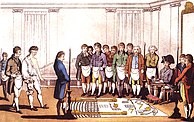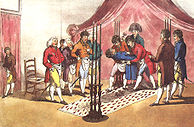Temple work
The Freemasons and Mormons refer to their closed ritual meetings as temple work .
In the Masonic language, the term “temple” stands on the one hand for the ritual space in the lodge house and on the other hand, in a symbolic way, for the embodiment of the desired Masonic ideals, which the Brotherhood of Masons symbolically equates with the Solomonic Temple . Each brother should, like a “stone”, be inserted into the overall structure of such a “temple” by performing the rituals or, to put it less metaphorically , put Masonic ideas into practice.
|
Initiation of a seeker engraving, 1745 in France |
|
Journeyman Carriage Engraving, 18th century |
|
Master survey of a journeyman engraving, 18th century |
| Instruction work in the 18th century |
Basics and history
The symbolism used in the temple work of Freemasonry consists in its basic ritual form of various images and actions that are often historically handed down and to which certain interactions with the mind of those who perform them are ascribed.
Ritual texts from the early days of Freemasonry have not survived, making it difficult to reconstruct the original customs. The rituals have often changed over time and are not uniform in Freemasonry; however, they are basically the same in their structure of the three degrees of Johannis .
In the second half of the 18th century , the so-called “ Strict Observance ”, a complex system of hierarchical gradations, was established in European Freemasonry. At the beginning of the 1780s, a counter-movement began to revert to the old ritual of the three degrees (apprentice - journeyman - master).
In this reform process, Georg Heinrich Sieveking also called for the abolition of “ hieroglyphs and symbols” and called these and the customs a farce. Friedrich Ludwig Schröder responded with his speech on “Morality and courtesy as the basic material of friendship and our pictorial signs and secrets” in his Emanuel box . In it he equated this requirement with the dissolution of Freemasonry and showed its relevance for the big brother chain. This led to speeches between the two and ultimately resulted in Sieveking resigning from his position as Master of the Chair on April 10, 1790 and giving up his previous involvement in Freemasonry.
Taking into account old English ritual texts, the 18th century set about reconstructing Masonic rituals in their supposed sense of origin. Here, Friedrich Ludwig Schröder deserves special credit. As a historical autodidact, he collected materials on the history of Freemasonry from its creation until 1723, which he published in 1815. On the basis of these studies, in collaboration with Johann Gottfried Herder, he created German rituals for the three degrees that are still in use today as Schröder's teaching style and are characterized by their simple clarity and ritual dynamics.
According to the pronouncements of the Freemasons, the individual interpretation and interpretation of the symbolism used is not dogmatically laid down, rather the freedom of the individual's way of looking at things is given an important role. Stimulants such as incense or trance techniques as part of the rituals are rejected.
Freemasonry is often accused of withholding information about detailed forms and contents of the rituals, on the one hand by self-imposed silence to protect its members and "knowledge" ( see also: Arcane principle ), but also by the fact that personal ritual experiences are fundamentally not communicable.
Procedure and clothing
The course of the ritual is carried through a fixed exchange conversation between the master from the chair and the so-called first and second overseer . In continental European lodges a lecture by the speaker on Masonic or other topics belongs to temple work (called drawing ).
Freemasons wear certain traditional clothing for lodge work . Today this consists among other things of a dark suit or tuxedo , the jewelry badge of the respective lodge (the so-called " bijou "), the symbolic mason's apron , white gloves and the so-called "high hat", a cylinder, which is still common in some lodges .
literature
- Helmut Reinalter : The Freemasons . 3. Edition. CH Beck-Verlag, Munich 2002, ISBN 3-406-44733-3




